Ever heard of Feng Shui and its power to bring harmony and balance to your living space? Most people associate it with furniture placement and color schemes, but did you know your home’s exterior plays a big role too? That’s right, from the layout of roads, to the proximity of landmarks, and the direct view of a cemetery, external features can significantly impact the flow of positive energy, or Qi, in your life.
Think of your house as a living, breathing organism. Just like you wouldn’t ignore your body’s external cues like sunlight or fresh air, your home thrives on the energy it receives from its surroundings. By understanding how external features influence Qi, you can unlock a whole new level of well-being in your own personal sanctuary.
So, whether you’re building a new dream home or looking to tweak your current abode, buckle up! We’re about to delve into the fascinating world of external Feng Shui and explore 17 features that might be unknowingly blocking your path to good vibes. Ready to transform your home into an oasis of positive energy? Let’s go!
1. House Facing a Tilted Road
When a house is positioned facing a tilted road, it can disrupt the smooth flow of energy, or qi, according to Feng Shui principles. The slanting nature of the road creates an imbalance in the energy entering the house, potentially leading to challenges in various aspects of life for the residents. This imbalance may manifest in difficulties related to health, relationships, finances, and overall well-being.
In Feng Shui, the flow of energy is paramount, as it is believed to influence every aspect of life. A tilted road can act as an obstacle, hindering the positive energy from circulating freely around the house. As a result, the residents may experience feelings of stagnation, obstacles in achieving their goals, and a lack of vitality.
Remedies to Counteract Negative Effects
To counteract the negative effects of a house facing a tilted road, several Feng Shui remedies can be implemented:
- Use of Protective Landscaping: Planting trees, bushes, or hedges along the boundary of the property can help deflect the negative energy from the tilted road. These landscaping features act as a barrier, absorbing and diffusing the harmful qi before it reaches the house.
- Installation of a Protective Fence or Wall: Erecting a fence or wall between the house and the tilted road can create a sense of boundary and protection. This physical barrier helps to block the direct flow of negative energy towards the house, maintaining a more balanced environment within.
- Placement of Feng Shui Cures: Introducing Feng Shui cures, such as mirrors, wind chimes, or bagua mirrors, strategically around the exterior of the house can help redirect and balance the flow of energy. These cures are believed to deflect negative energy and invite positive energy into the space, enhancing the overall harmony and well-being of the residents.
2. House Facing Intersecting Roads
In Feng Shui philosophy, intersecting roads are considered sources of negative energy that can disrupt the flow of qi, the vital life force, around a house. When a house is positioned facing intersecting roads, it becomes vulnerable to the collision of conflicting energies, which can result in various challenges for the residents.

The converging energy from the intersecting roads creates a chaotic and turbulent environment, making it difficult for positive energy to permeate the space. This disruption in energy flow can lead to feelings of instability, stress, and discord within the household. Additionally, the constant movement and noise associated with intersecting roads can contribute to a sense of restlessness and unease among the residents.
Feng Shui principles emphasize the importance of maintaining a harmonious and balanced environment to support the well-being of the inhabitants. Therefore, it is essential to address the negative influences caused by a house facing intersecting roads to create a more auspicious living space.
Feng Shui Tips to Mitigate Negative Influences
To mitigate the negative influences of a house facing intersecting roads, consider implementing the following Feng Shui tips:
- Create a Protective Barrier: Erect a fence, wall, or dense landscaping along the front of the house facing the intersecting roads. This barrier serves as a buffer, shielding the house from the direct impact of negative energy and providing a sense of protection for the residents.
- Enhance the Front Entryway: Pay special attention to the front entryway of the house, as it serves as the main point of entry for energy. Enhance the curb appeal and attractiveness of the entryway to invite positive energy into the home. Use vibrant colors, well-maintained landscaping, and auspicious symbols to attract auspicious qi and counteract the negative influences of intersecting roads.
- Utilize Feng Shui Remedies: Incorporate Feng Shui remedies, such as mirrors, crystals, or wind chimes, strategically around the exterior of the house to deflect negative energy and promote harmony. Place mirrors or reflective surfaces facing the intersecting roads to redirect and disperse the flow of harmful qi away from the house. Additionally, hang wind chimes or crystals near the front entrance to activate positive energy and create a sense of tranquility.
Related reading: Avoid Bad Feng Shui: 12 House Features to Improve – Opens in new tab
3. House Near a High-Traffic Area or Freeway
Living near a high-traffic area or freeway can introduce disruptive effects on the energy flow within a house. The constant noise, pollution, and activity associated with heavy traffic can create challenges in maintaining a harmonious and peaceful living environment. In Feng Shui philosophy, external factors such as traffic can impact the flow of qi, or positive energy, around the house, influencing the well-being and quality of life of its inhabitants.

The noise generated by constant traffic can disrupt the tranquility of the environment, leading to feelings of stress, agitation, and discomfort among residents. Additionally, pollution from vehicle emissions can affect air quality, contributing to respiratory issues and other health concerns.
The fast-paced nature of traffic can also create a sense of instability and restlessness within the household, as the constant movement and activity may disturb the natural balance and harmony of the environment.
Practical Tips for Shielding the House from Noise and Pollution
To shield the house from noise and pollution associated with high-traffic areas or freeways, consider implementing the following practical tips:
- Create a Barrier: Establish a physical barrier between the house and the high-traffic area to minimize the direct impact of noise and pollution. This can be achieved by installing a fence, wall, or dense landscaping along the perimeter of the property to create a buffer zone that helps absorb sound and filter air pollutants.
- Enhance Insulation: Improve the insulation of windows, walls, and doors to reduce the transmission of noise from outside sources into the house. Consider installing double-glazed windows, weather-stripping, or soundproof curtains to create a quieter and more peaceful indoor environment.
- Use Air Purifiers: Install air purifiers or filtration systems within the house to remove pollutants and improve indoor air quality. High-quality air purifiers can help to capture airborne particles, allergens, and toxins, creating a healthier and more comfortable living environment for residents.
- Plant Trees and Shrubs: Planting trees, shrubs, or other vegetation around the perimeter of the property can help absorb noise and filter air pollutants from the surrounding environment. Choose dense and leafy plants that provide effective sound and air insulation while enhancing the beauty of the landscape.
- Optimize Interior Layout: Arrange the interior layout of the house to minimize exposure to noise and pollution from the high-traffic area. Position bedrooms, living areas, and other sensitive spaces away from the side of the house facing the traffic to create a quieter and more peaceful living environment.
🍀 Our “Feng Shui Master” app is your trusted companion, offering a useful guide to implementing Feng Shui principles. Try it now!
4. House Facing a T-Junction
In Feng Shui, a house facing a T-junction is considered to be in a vulnerable position, as it is directly exposed to the rushing energy from the intersecting roads. The T-junction creates a fast and turbulent flow of energy, which can disrupt the natural balance and harmony within the environment. This disruptive energy flow can manifest in various challenges for the residents, including feelings of instability, stress, and uncertainty.

The sharp angle of the T-junction directs a concentrated stream of energy towards the front of the house, creating a sense of pressure and imbalance. This intense energy can overwhelm the space and make it challenging for positive energy to circulate freely. Additionally, the constant movement and noise associated with a T-junction can contribute to a sense of restlessness and agitation among the residents.
Implementing Feng Shui Adjustments to Alleviate Negative Effects
To alleviate the negative effects of a house facing a T-junction, consider implementing the following Feng Shui adjustments:
- Create a Protective Barrier: Install a fence, wall, or dense landscaping along the front of the house facing the T-junction to create a sense of protection and privacy. This barrier acts as a buffer, deflecting the rushing energy from the intersecting roads and creating a more tranquil environment within the property.
- Enhance the Front Entryway: Pay special attention to the design and layout of the front entryway, as it serves as the main point of entry for energy. Enhance the curb appeal and attractiveness of the entryway to invite positive energy into the home. Use vibrant colors, well-maintained landscaping, and auspicious symbols to create a welcoming and harmonious atmosphere.
- Utilize Feng Shui Cures: Incorporate Feng Shui cures, such as mirrors, crystals, or wind chimes, to redirect and balance the flow of energy. Place mirrors strategically to reflect and expand positive energy throughout the space. Hang wind chimes or crystals near the front entrance to activate positive energy and create a sense of tranquility.
- Optimize Interior Layout: Arrange the interior layout of the house to create a sense of balance and harmony. Position furniture and decor in a way that promotes the smooth flow of energy throughout the space. Avoid placing furniture directly in line with the T-junction, as this can amplify the disruptive energy flow.
Related reading: 18 Interior Design Elements that are BAD Feng Shui – Opens in new tab
5. House at the End of a Long Straight Road
A house located at the end of a long straight road may experience an accumulation of excessive energy due to the uninterrupted flow of qi, or energy, along the road. In Feng Shui philosophy, this buildup of energy can create a sense of pressure and intensity at the termination point of the road, impacting the environment and the residents of the house.

The straight and unobstructed nature of the road allows energy to travel swiftly and directly toward the endpoint, resulting in a concentration of energy at the house. This excessive energy buildup can manifest in various ways, including feelings of tension, restlessness, and overwhelm within the household.
Additionally, the constant flow of energy may disrupt the natural balance and harmony of the environment, leading to challenges in maintaining a sense of peace and tranquility.
Practical Feng Shui Remedies to Balance the Energy Flow
To balance the energy flow and alleviate the excessive energy buildup at the end of a straight road, consider implementing the following Feng Shui remedies:
- Create a Curved Pathway: Introduce a curved pathway or driveway leading to the house to slow down the flow of energy and disperse it more evenly throughout the property. The gentle curves and bends in the pathway help to soften the direct flow of qi and promote a more harmonious energy distribution.
- Plant Trees and Shrubs: Planting trees, shrubs, or other landscaping features along the roadside can help absorb and diffuse excessive energy, creating a buffer between the house and the road. Choose dense and lush vegetation to provide a sense of protection and privacy while enhancing the natural beauty of the environment.
- Install a Water Feature: Incorporate a water feature, such as a fountain, pond, or waterfall, near the entrance of the house to promote the flow of positive energy and create a sense of tranquility. Water is a powerful Feng Shui element that helps to balance and harmonize the energy of a space, making it an ideal addition to counteract the excessive energy buildup.
- Utilize Feng Shui Symbols: Place Feng Shui symbols, such as mirrors, crystals, or wind chimes, strategically around the exterior of the house to redirect and balance the flow of energy. Mirrors can be positioned to reflect and expand positive energy, while crystals and wind chimes can help to activate and harmonize the energy of the environment.
- Optimize Interior Layout: Arrange the interior layout of the house to create a sense of balance and harmony that complements the external environment. Position furniture and decor in a way that promotes the smooth flow of energy throughout the space, avoiding sharp angles and clutter that may obstruct the flow of qi.
Related reading: Effects of Bad Feng Shui on Your Life and How to Fix It – Opens in new tab
6. House Beneath Power Lines
Living beneath power lines can introduce several adverse effects on the health and well-being of residents, primarily due to electromagnetic disturbances emitted by the power lines. Electromagnetic fields (EMFs) generated by power lines have been linked to various health concerns, including increased risk of cancer, disrupted sleep patterns, and negative impacts on mental health.
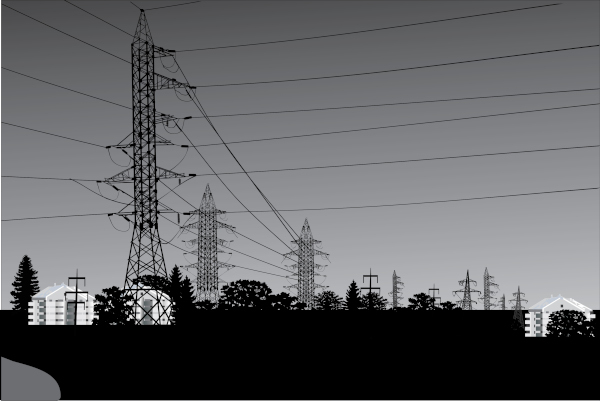
Exposure to high levels of EMFs over an extended period may lead to a range of health issues, such as headaches, fatigue, and stress. The constant presence of electromagnetic disturbances can also affect the body’s natural energy balance, leading to feelings of discomfort and unease within the household.
While scientific research on the health effects of EMFs is ongoing, many people remain cautious about living in close proximity to power lines due to the potential risks associated with prolonged exposure.
Strategies to Diminish Electromagnetic Disturbances
To diminish the electromagnetic disturbances caused by living beneath power lines, consider implementing the following strategies:
- Increase Distance from Power Lines: If possible, relocate or choose a different property that is farther away from power lines. Increasing the distance between the house and the power lines can help reduce exposure to electromagnetic fields and minimize potential health risks.
- Create a Protective Barrier: Install shielding materials, such as metal sheeting or special fabrics, around the perimeter of the house to block or absorb electromagnetic radiation. Creating a barrier between the house and the power lines can help reduce the intensity of electromagnetic disturbances within the living space.
- Minimize Time Spent Outdoors: Limit outdoor activities, particularly in areas directly beneath or adjacent to power lines, to reduce exposure to electromagnetic fields. Encourage family members to spend more time indoors or in areas of the property located farther away from the power lines.
- Utilize EMF Shielding Devices: Consider using EMF shielding devices or products designed to reduce exposure to electromagnetic radiation. These may include EMF shielding paint, curtains, or bed canopies that create a protective barrier within the home environment.
- Promote Health and Wellness: Focus on promoting overall health and wellness within the household by adopting healthy lifestyle habits and practices. Encourage regular exercise, proper nutrition, and stress-reduction techniques to support the body’s natural resilience to environmental stressors.
Want to learn more about Feng Shui? Take a look at these Courses and Books – Aff.link
7. House Facing a Sharp Corner
When a house is positioned facing a sharp corner, it is exposed to the sharp, cutting energy associated with the angle of the corner. In the world of Feng Shui, these “poison arrows”, as they’re called, can unleash a potent burst of negative energy, often leading to feelings of anxiety, arguments, and even health issues.
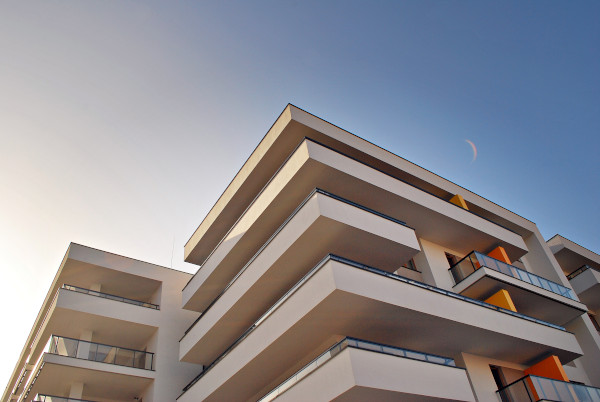
Sharp corners, whether on buildings or natural structures, are seen in Feng Shui as emitting a concentrated and often harmful energy. Imagine a pointed arrow aimed directly at your home – that’s the energetic force a corner can generate. This potent energy, known as Sha Qi, can disrupt the natural flow of positive energy (Qi) within your home, leading to a range of imbalances.
Techniques to Soften the Impact and Promote Harmony
To soften the impact of the sharp corner and promote harmony within the environment, consider implementing the following techniques:
- Use Softening Landscaping: Planting softening landscaping features, such as curved pathways, rounded shrubs, or cascading vines, can help soften the sharp edges of the corner and create a more gentle and flowing energy. Choose plants with soft, rounded shapes and textures to counteract the sharp energy of the corner and promote a sense of tranquility.
- Install a Water Feature: Incorporating a water feature, such as a fountain or pond, near the sharp corner can help to soften the energy and promote a sense of balance and harmony. Water is a powerful Feng Shui element that helps to activate positive energy and create a sense of calm and serenity within the environment.
- Use Feng Shui Cures: Place Feng Shui cures, such as mirrors, crystals, or wind chimes, strategically around the exterior of the house to redirect and balance the flow of energy. Mirrors can be positioned to reflect and expand positive energy, while crystals and wind chimes can help to activate and harmonize the energy of the environment.
- Create a Protective Barrier: Installing a barrier, such as a fence, wall, or dense landscaping, between the house and the sharp corner can help to shield the house from the direct impact of negative energy. This barrier acts as a buffer, deflecting the sharp energy and creating a sense of protection and privacy for the residents.
- Optimize Interior Layout: Arrange the interior layout of the house to create a sense of balance and harmony that complements the external environment. Position furniture and decor in a way that promotes the smooth flow of energy throughout the space, avoiding sharp angles and clutter that may exacerbate the sharp energy of the corner.
Related reading: Mastering Feng Shui Maintenance: Your Guide to Harmonious Living – Opens in new tab
8. House Near a Cemetery
In Feng Shui philosophy, the proximity of a house to a cemetery holds significant importance as it can impact the flow of qi, or energy, in the surrounding environment. Cemeteries are considered places of yin energy, associated with death and mourning, which can create a heavy and stagnant energy field. When a house is located near a cemetery, it may be influenced by this negative energy, affecting the well-being and harmony of its inhabitants.

According to Feng Shui principles, the energy of the land directly affects the energy of a house and its occupants. Therefore, living near a cemetery can introduce challenges related to health, relationships, and overall prosperity. The presence of yin energy from the cemetery may contribute to feelings of sadness, stagnation, and discomfort within the household.
Suggestions for Enhancing Positive Energy Despite the Location
Despite the challenges posed by living near a cemetery, there are several Feng Shui suggestions for enhancing positive energy and creating a harmonious living environment:
- Create a Protective Barrier: Establish a barrier between the house and the cemetery to minimize the direct impact of negative energy. Planting dense vegetation, such as trees, shrubs, or hedges, along the property boundary can act as a buffer, shielding the house from the yin energy of the cemetery.
- Focus on the Front Entryway: Pay special attention to the front entryway of the house to invite positive energy into the home. Enhance the curb appeal and attractiveness of the entryway by using vibrant colors, well-maintained landscaping, and auspicious symbols. Creating a welcoming and inviting entrance can help counteract the negative influences of the nearby cemetery.
- Cleanse and Purify the Space: Regularly cleanse and purify the energy of the house to remove any lingering negative vibrations. This can be done through smudging with sage or using sound healing techniques, such as ringing bells or playing soothing music. Clearing the space of stagnant energy can help create a more uplifting and harmonious atmosphere.
- Focus on Positive Intentions: Cultivate a positive mindset and intention within the household to counteract the effects of negative energy. Practice gratitude, positivity, and mindfulness to shift the energy towards a more uplifting and supportive vibration. By focusing on positive intentions, residents can create a sense of empowerment and resilience despite the challenges of living near a cemetery.
🍀 Our “Feng Shui Master” app is your trusted companion, offering a useful guide to implementing Feng Shui principles. Try it now!
9. House Adjacent to a Hospital or Fire Station
Living adjacent to a hospital or fire station can expose a house to disruptive energy stemming from the constant activity and urgency associated with emergency service facilities. While convenient for emergencies, living next to a hospital or fire station can introduce a unique set of energetic challenges in the realm of Feng Shui. The constant activity, flashing lights, and emergency sirens can create a sense of disruption and unease, potentially impacting your home’s harmony.

Hospitals and fire stations, while vital community services, emit a constant flow of active energy. This can manifest as feelings of restlessness, anxiety, or even sleep disturbances. Additionally, the frequent use of sirens and flashing lights creates a form of Sha Qi, or sharp energy, that can disrupt the natural flow of positive energy (Qi) within your home.
Additionally, the constant presence of emergency service vehicles and personnel can contribute to a sense of instability and unpredictability in the neighborhood.
Tips for Neutralizing Negative Influences on the House
To neutralize the negative influences of living adjacent to a hospital or fire station, consider implementing the following tips:
- Create a Barrier: Establish a barrier between the house and the emergency service facility to minimize the direct impact of disruptive energy. This can be achieved by planting dense vegetation, installing a fence or wall, or using other landscaping features to create a sense of privacy and protection.
- Enhance the Front Entrance: Pay special attention to the front entrance of the house to invite positive energy and counteract the disruptive influences from the nearby facility. Enhance the curb appeal and attractiveness of the entrance with well-maintained landscaping, inviting lighting, and auspicious symbols to create a welcoming and harmonious atmosphere.
- Utilize Feng Shui Cures: Incorporate Feng Shui cures, such as mirrors, crystals, or wind chimes, strategically around the exterior of the house to deflect negative energy and promote harmony. Mirrors can be positioned to reflect and expand positive energy, while crystals and wind chimes can help to activate and harmonize the energy of the environment.
- Optimize Interior Layout: Arrange the interior layout of the house to create a sense of balance and tranquility that counteracts the disruptive influences from the nearby facility. Position furniture and decor in a way that promotes the smooth flow of energy throughout the space, avoiding clutter and sharp angles that may exacerbate the disruptive energy.
- Practice Mindfulness and Relaxation Techniques: Encourage mindfulness and relaxation techniques within the household to help residents cope with the disruptive influences from the nearby facility. Practice meditation, deep breathing exercises, or yoga to promote a sense of calm and resilience in the face of external stressors.
Related reading: Surrounding Buildings that are BAD Feng Shui and How to Overcome Their Effect – Opens in new tab
10. House Near Industrial Sites or Factories
Living near industrial sites or factories can have a significant impact on the Feng Shui of a house, primarily due to pollution and noise generated by industrial activities. In Feng Shui philosophy, a clean and peaceful environment is essential for promoting harmony and well-being.
However, the presence of pollution and noise from industrial sources can disrupt the natural balance and harmony of the environment, leading to various challenges for the residents.

Pollution from industrial activities, such as air and water pollution, can have detrimental effects on health and overall well-being. Exposure to pollutants may lead to respiratory problems, allergies, and other health issues, impacting the quality of life for residents. Additionally, noise pollution from industrial machinery and equipment can contribute to feelings of stress, irritability, and discomfort within the household.
Suggestions for Shielding the House from Industrial Disturbances
To shield the house from industrial disturbances and minimize the negative impacts on Feng Shui, consider implementing the following suggestions:
- Create a Physical Barrier: Install a barrier, such as a fence, wall, or dense landscaping, between the house and the industrial site to minimize the direct impact of pollution and noise. This barrier acts as a buffer, helping to block or absorb pollutants and sound waves before they reach the house.
- Plant Trees and Shrubs: Planting trees, shrubs, or other vegetation around the perimeter of the property can help to absorb pollutants and provide a natural barrier against noise. Choose dense and lush vegetation to create a green buffer zone that helps to purify the air and dampen sound levels.
- Use Air Purifiers and Filters: Install air purifiers and filters in the house to remove pollutants and improve indoor air quality. High-quality air purifiers can help to remove particles, odors, and toxins from the air, creating a healthier and more comfortable living environment for residents.
- Soundproofing Measures: Implement soundproofing measures, such as installing double-glazed windows, sealing gaps and cracks, and using sound-absorbing materials, to minimize the transmission of noise from industrial sources. Soundproofing helps to create a quieter and more peaceful indoor environment, reducing the impact of industrial disturbances on residents.
- Utilize Feng Shui Remedies: Incorporate Feng Shui remedies, such as mirrors, crystals, or wind chimes, strategically around the exterior of the house to deflect negative energy and promote harmony. Mirrors can be positioned to reflect and expand positive energy, while crystals and wind chimes can help to activate and harmonize the energy of the environment.
Related reading: Why Your Feng Shui Doesn’t Work? 9 Reasons and How to Fix Them – Opens in new tab
11. House Facing a Steep Slope or Cliff
When a house is positioned facing a steep slope or cliff, it can evoke feelings of instability and insecurity due to the inherent risks and challenges associated with such terrain. In Feng Shui philosophy, the physical environment plays a significant role in shaping the energy of a space, and steep slopes are often perceived as sources of imbalance and vulnerability.

The steep incline of the slope or cliff creates a sense of precariousness and uncertainty, as the land may be prone to erosion, landslides, or other natural hazards. This “missing” support can manifest in feelings of anxiety, restlessness, or even difficulty making financial decisions. Imagine standing at the edge of a cliff – the feeling of exposure and potential danger resonates with the energetic instability represented by such a landscape.
Additionally, the steep slope or cliff may obstruct the flow of qi, or energy, around the house, leading to challenges in maintaining balance and harmony within the environment. The sharp descent of the terrain can create a sense of downward pressure, which may manifest in feelings of heaviness, stagnation, and lack of vitality within the household.
Feng Shui Methods to Stabilize and Enhance the Environment
To stabilize and enhance the environment of a house facing a steep slope or cliff, consider implementing the following Feng Shui methods:
- Terracing and Retaining Walls: Create terraced gardens or install retaining walls along the slope to stabilize the terrain and prevent erosion. Terracing helps to break up the steep incline into smaller, manageable levels, allowing for the cultivation of vegetation and the creation of functional outdoor spaces. Retaining walls provide structural support and prevent soil from shifting or sliding down the slope, creating a more stable and secure environment.
- Plant Trees and Shrubs: Planting trees, shrubs, or other vegetation along the slope can help to stabilize the soil, reduce erosion, and enhance the beauty of the landscape. Choose native plants with deep root systems that can anchor the soil and prevent erosion. Additionally, planting trees can provide shade, habitat for wildlife, and create a sense of tranquility and harmony within the environment.
- Use Feng Shui Cures: Incorporate Feng Shui cures, such as mirrors, crystals, or wind chimes, strategically around the exterior of the house to redirect and balance the flow of energy. Mirrors can be positioned to reflect and expand positive energy, while crystals and wind chimes can help to activate and harmonize the energy of the environment.
- Create a Sense of Enclosure: Establish boundaries around the property to create a sense of enclosure and protection. This can be achieved by installing fences, walls, or dense landscaping along the perimeter of the property. Creating a physical barrier helps to define the space and provide a sense of security for the residents.
- Optimize Interior Layout: Arrange the interior layout of the house to maximize stability and security. Position furniture and decor in a way that creates a sense of groundedness and support, avoiding placing heavy objects or furniture near windows or doors facing the slope or cliff. Additionally, ensure that structural elements of the house are well-maintained and structurally sound to withstand any potential risks associated with the terrain.
Related reading: 11 Feng Shui Benefits That Will Transform Your Life (From Sleep to Success!)-Opens in new tab
12. House Near Water Drainage or Sewage Systems
In Feng Shui philosophy, water is a powerful element that symbolizes flow, abundance, and vitality. However, when a house is located near water drainage or sewage systems, it can introduce potential hazards and challenges to the environment due to the negative energy associated with stagnant or polluted water.
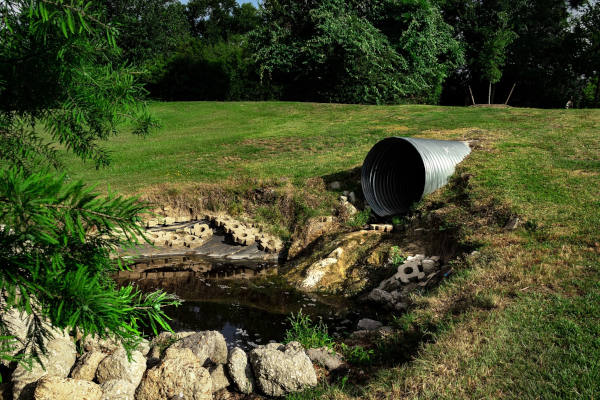
Water drainage or sewage systems may carry stagnant or polluted water, which can emit negative energy and create disruptions in the flow of qi, or energy, around the house. Stagnant water is believed to represent stagnant energy, which can lead to feelings of stagnation, blockages, and obstacles in various aspects of life.
Additionally, water drainage or sewage systems may emit unpleasant odors, toxins, and pollutants, which can adversely affect the health and well-being of residents. Exposure to polluted water may lead to health issues such as respiratory problems, infections, and allergic reactions, further exacerbating the challenges faced by residents living near such systems.
Measures to Purify and Redirect Negative Water Energy
To purify and redirect negative water energy associated with water drainage or sewage systems, consider implementing the following measures:
- Create a Physical Barrier: Establish a barrier between the house and the water drainage or sewage systems to minimize the direct impact of negative water energy. This can be achieved by installing a fence, wall, or dense landscaping along the perimeter of the property to create a sense of protection and privacy.
- Enhance Water Features: Introduce water features, such as ponds, fountains, or streams, within the property to activate positive water energy and counteract the negative effects of nearby drainage or sewage systems. Flowing water symbolizes movement, purification, and vitality, helping to cleanse and harmonize the energy of the environment.
- Use Feng Shui Cures: Incorporate Feng Shui cures, such as mirrors, crystals, or wind chimes, strategically around the exterior of the house to redirect and balance the flow of energy. Mirrors can be positioned to reflect and expand positive energy, while crystals and wind chimes can help to activate and harmonize the energy of the environment.
- Install Filtration Systems: Install filtration systems or water purification devices to cleanse and purify the water supply within the house. High-quality filtration systems can help remove pollutants, toxins, and impurities from the water, ensuring a healthier and safer living environment for residents.
- Optimize Interior Layout: Arrange the interior layout of the house to maximize the flow of positive energy and minimize exposure to negative water energy. Position furniture and decor in a way that promotes a sense of balance and harmony, avoiding placing heavy objects or furniture near windows or doors facing the water drainage or sewage systems.
13. House with Overhanging Structures
When a house is situated beneath overhanging structures, such as bridges, balconies, or protruding rooftops, it can experience oppressive energy due to the downward pressure exerted by these structures. In Feng Shui philosophy, overhanging structures are believed to symbolize burdens, obstacles, and limitations, which can create feelings of constriction and discomfort within the environment.
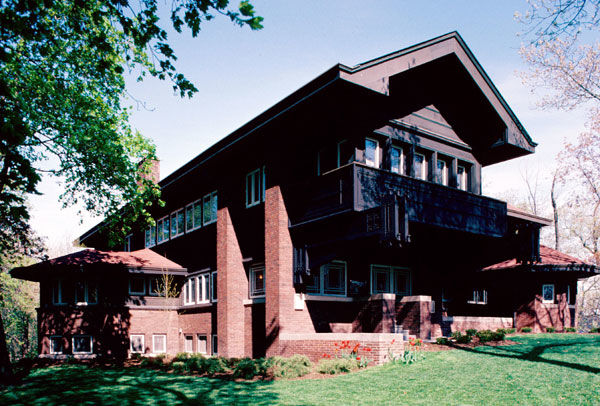
The presence of overhanging structures casts a shadow over the house, both literally and metaphorically, creating a sense of heaviness and oppression. This downward pressure can obstruct the flow of qi, or energy, around the house, leading to feelings of stagnation, restriction, and lack of vitality. Additionally, the oppressive energy from overhanging structures may contribute to challenges in maintaining balance and harmony within the environment.
Solutions to Mitigate the Downward Pressure and Promote Balance
To mitigate the downward pressure and promote balance in a house with overhanging structures, consider implementing the following solutions:
- Create a Protective Barrier: Install a barrier, such as a fence, wall, or dense landscaping, between the house and the overhanging structures to minimize the direct impact of oppressive energy. This barrier acts as a buffer, helping to deflect negative energy and create a sense of protection and privacy for the residents.
- Utilize Feng Shui Cures: Incorporate Feng Shui cures, such as mirrors, crystals, or wind chimes, strategically around the exterior of the house to redirect and balance the flow of energy. Mirrors can be positioned to reflect and expand positive energy, while crystals and wind chimes can help to activate and harmonize the energy of the environment.
- Enhance the Front Entryway: Pay special attention to the front entryway of the house to counteract the oppressive energy from overhanging structures. Enhance the curb appeal and attractiveness of the entryway with well-maintained landscaping, inviting lighting, and auspicious symbols to create a welcoming and harmonious atmosphere.
- Optimize Interior Layout: Arrange the interior layout of the house to maximize balance and flow of energy within the space. Position furniture and decor in a way that creates a sense of openness and lightness, avoiding placing heavy objects or furniture directly beneath overhanging structures. Additionally, ensure that structural elements of the house are well-maintained and structurally sound to withstand any potential risks associated with the overhanging structures.
- Foster Positive Intentions: Cultivate a positive mindset and intention within the household to counteract the oppressive energy from overhanging structures. Practice gratitude, mindfulness, and positivity to shift the energy towards a more uplifting and supportive vibration, fostering a sense of resilience and empowerment within the environment.
14. House with Broken or Cracked Exterior Features
In the world of Feng Shui, broken or cracked features symbolize energetic leaks and imbalances. They not only detract from the visual appeal of your home but can also hinder the flow of positive energy (Qi), potentially leading to feelings of stagnation, negativity, and even financial strain.
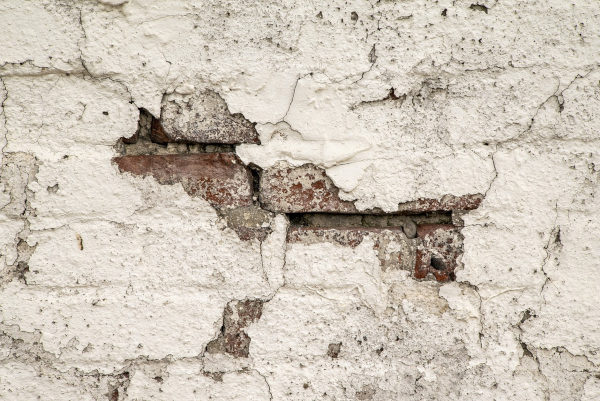
Additionally, the exterior of your home represents its protective shell and energetic shield. Broken or cracked features symbolize weaknesses in this shield, allowing negative energy to seep in and positive energy to escape. Imagine a cracked eggshell – its protective function is compromised, leaving the yolk vulnerable. Similarly, damaged exterior features can leave your home’s energy vulnerable and imbalanced.
Steps to Repair and Revitalize Damaged External Features
To repair and revitalize damaged external features of a house, consider implementing the following steps:
- Prioritize Repairs: Prioritize repairs based on the severity of the damage and the potential impact on the overall integrity of the house. Address critical issues such as structural damage or water leaks first to prevent further deterioration and ensure the safety and stability of the house.
- Replace Broken Features: Replace broken or damaged exterior features, such as windows, doors, siding, or roofing materials, with new and high-quality materials that complement the architectural style of the house. Choose durable and weather-resistant materials that can withstand the elements and provide long-lasting protection.
- Repaint and Refresh: Repaint and refresh the exterior of the house to enhance its appearance and vitality. Choose colors that resonate with the principles of Feng Shui, such as earth tones for stability and grounding, or vibrant hues for energy and vitality. Repainting can breathe new life into the house and create a sense of renewal and rejuvenation.
- Enhance Curb Appeal: Improve curb appeal by adding decorative elements, landscaping, or outdoor lighting to enhance the beauty and attractiveness of the exterior space. A well-maintained and visually appealing exterior creates a positive first impression and invites positive energy into the environment.
- Maintain Regular Maintenance: Establish a routine maintenance schedule to keep the exterior features of the house in good condition. Regularly inspect and clean gutters, trim trees and shrubs, repair any minor damage promptly, and address any issues before they escalate into larger problems.
15. House with Overgrown or Dying Plants
In Feng Shui, the landscape surrounding your home plays a crucial role in shaping its energy. The external appearance of a house, including the condition of its plants and landscaping features, reflects the overall health and vitality of the space, influencing the flow of qi, or energy, within the environment.

Plants, in Feng Shui, are seen as living symbols of growth, vitality, and positive energy. They act as natural filters, absorbing negativity and emitting beneficial energy into your home.
However, overgrown or dying plants symbolize neglect, stagnation, and imbalance, which can disrupt the flow of positive energy and create challenges in maintaining harmony and prosperity within the household. Imagine a choked garden – it reflects a lack of life and vibrancy, mirroring the potentially energetic state of your home.
Advice for Revitalizing the External Environment Through Plant Care
To revitalize the external environment of a house with overgrown or dying plants, consider implementing the following plant care tips:
- Prune and Trim: Prune and trim overgrown plants to restore their shape and vitality. Remove dead or diseased branches, and trim back excessive growth to promote healthy growth and maintain an attractive appearance. Pruning encourages new growth and helps to rejuvenate the plant’s energy.
- Water and Fertilize: Ensure that plants receive adequate water and nutrients to support their growth and vitality. Water plants deeply and consistently, especially during hot and dry periods, and fertilize them regularly with a balanced fertilizer to provide essential nutrients for healthy growth.
- Replace with Vibrant Plants: Replace dead or dying plants with vibrant and healthy ones that complement the overall aesthetic of the landscape. Choose plants that thrive in the local climate and soil conditions, and select a variety of species to create visual interest and diversity within the environment.
- Mulch and Weed: Apply mulch around plants to conserve moisture, suppress weeds, and improve soil health. Mulching also helps to regulate soil temperature and reduce erosion, creating a more favorable environment for plant growth. Additionally, regularly remove weeds to prevent them from competing with plants for nutrients and sunlight.
- Regular Maintenance: Establish a routine maintenance schedule to keep plants healthy and thriving. Monitor plants for signs of pests, diseases, or other issues, and address any problems promptly to prevent them from spreading. Regularly prune, water, fertilize, and mulch plants to maintain their health and vitality throughout the year.
16. House with Blocked Entrance or Pathways
In Feng Shui philosophy, the flow of qi, or energy, within the environment is essential for promoting harmony, vitality, and well-being. The entrance to your home represents the “mouth of Qi,“ the point where energy enters and nourishes your life.

Blocked entrances or pathways disrupt the natural circulation of energy, creating stagnation, obstacles, and challenges within the household. When entrances or pathways are blocked, energy is unable to flow freely throughout the space, leading to feelings of constriction, frustration, and lack of opportunities.
Blocked entrances prevent the smooth entry and exit of energy into and out of the house, creating a barrier that inhibits the flow of positive energy. This obstruction can manifest in various aspects of life, including relationships, career, and health, as the blocked energy is unable to circulate and nourish the environment. Additionally, blocked pathways disrupt the movement of energy within the environment, leading to feelings of stagnation and inertia.
Feng Shui Remedies to Clear Obstacles and Restore Flow
To clear obstacles and restore the flow of energy in a house with blocked entrances or pathways, consider implementing the following Feng Shui remedies:
- Clear Clutter: Remove clutter and obstacles from entrances and pathways to create a clear and unobstructed flow of energy. Clutter prevents energy from circulating freely within the environment and creates blockages that inhibit growth and prosperity. Clearing clutter creates space for energy to flow and revitalizes the environment.
- Create Clear Pathways: Ensure that entrances and pathways are clear and inviting, with unobstructed access to the house. Remove obstacles such as furniture, plants, or debris that block the flow of energy and impede movement within the space. Creating clear pathways encourages the smooth circulation of energy and promotes a sense of openness and opportunity.
- Enhance Lighting: Illuminate entrances and pathways with bright and welcoming lighting to attract positive energy and enhance visibility. Lighting plays a crucial role in Feng Shui by activating and energizing the environment, promoting clarity, vitality, and prosperity. Install outdoor lighting fixtures or use solar-powered lights to illuminate pathways and entrances, creating a welcoming and inviting atmosphere.
- Use Mirrors: Place mirrors strategically near entrances or pathways to expand and reflect positive energy throughout the space. Mirrors help to redirect and amplify energy, creating a sense of spaciousness and abundance within the environment. Position mirrors to reflect natural light and beautiful views, enhancing the energy flow and revitalizing the space.
- Add Feng Shui Symbols: Incorporate Feng Shui symbols such as wind chimes, crystals, or auspicious objects near entrances or pathways to activate positive energy and dispel obstacles. Feng Shui symbols help to harmonize and balance the energy of the environment, creating a supportive and nourishing atmosphere. Choose symbols that resonate with your intentions and goals, and place them strategically to enhance the flow of energy.
17. House with Harsh Lighting or Glaring Reflections
Harsh lighting and glaring reflections can create discomfort and imbalance within a house, disrupting the natural flow of energy and detracting from the overall atmosphere. In Feng Shui philosophy, lighting plays a crucial role in shaping the energy of a space, influencing the mood, ambience, and well-being of its inhabitants.

When lighting is too harsh or intense, it can create feelings of agitation, discomfort, and fatigue, as well as cause glare and reflections that disrupt the visual harmony of the environment. Glaring reflections from windows, mirrors, or shiny surfaces can create visual distractions and discomfort within the space.
Excessive glare can strain the eyes, create visual discomfort, and contribute to feelings of irritability and stress. Additionally, harsh lighting can create harsh shadows and highlights, leading to uneven illumination and a lack of balance within the environment.
Suggestions for Softening the Lighting and Creating a More Inviting Atmosphere
To soften the lighting and create a more inviting atmosphere in a house with harsh lighting or glaring reflections, consider implementing the following suggestions:
- Use Soft Lighting: Replace harsh or intense lighting fixtures with softer and more diffused lighting options, such as recessed lighting, pendant lights, or wall sconces. Soft lighting creates a gentle and inviting atmosphere, reducing glare and creating a more comfortable environment for relaxation and socializing.
- Choose Warm Color Temperatures: Opt for lighting fixtures with warm color temperatures, such as soft white or warm white, to create a welcoming and inviting atmosphere. Warm light enhances the sense of comfort and coziness within the space, making it more inviting and conducive to relaxation and socializing.
- Use Window Treatments: Install window treatments such as curtains, blinds, or shades to control natural light and minimize glare and reflections from windows. Choose light-filtering or translucent materials that allow natural light to enter while diffusing harsh glare and creating a softer, more diffused lighting effect.
- Position Mirrors Carefully: Position mirrors strategically to reflect natural light and expand the sense of space, but avoid placing them in locations where they create glare or reflections that cause visual discomfort. Use anti-glare coatings or matte finishes on mirrors to reduce reflections and create a softer, more diffused reflection.
Conclusion: Your Home – A Haven of Harmony
Throughout this exploration of external challenges and their Feng Shui implications, we’ve delved into various scenarios, from facing cemeteries to navigating busy highways. While these external features may seem daunting, remember that Feng Shui empowers you to transform your home into a sanctuary, regardless of its surroundings.
By understanding the symbolic meaning of each element and implementing simple adjustments, you can cultivate a space that nurtures positive energy, promotes well-being, and reflects your unique desires. From strategically placed plants to the mindful use of light and mirrors, each step you take becomes a brushstroke on the canvas of your home’s energy.
Remember, Feng Shui is not about achieving perfection, but about creating a harmonious environment that supports your life journey. Embrace the journey, experiment with different techniques, and trust your intuition. As you nurture the energy within your home, you’ll be amazed at how it reflects and amplifies the positive energy within you.
So, step into your haven, breathe in the revitalized air, and bask in the warm glow of your mindful adjustments. Your home, once challenged by external factors, now hums with a vibrant energy, a testament to your dedication to creating a sanctuary that truly reflects your inner peace.
Want to learn more about Feng Shui? Take a look at these Courses and Books – Aff.link
Additional Resources
- WHO. (2018). Ambient air pollution: A global assessment of exposure and burden of disease. World Health Organization.
- Basner, M., Babisch, W., Davis, A., Brink, M., Clark, C., Janssen, S., & Stansfeld, S. (2014). Auditory and non-auditory effects of noise on health. The Lancet, 383(9925), 1325-1332. doi:10.1016/S0140-6736(13)61613-X.
- Evans, G. W., & Cohen, S. (1987). Environmental stress. In D. Stokols & I. Altman (Eds.), Handbook of environmental psychology (pp. 571-610). John Wiley & Sons
- Systematic review and meta-analysis of health effects associated with residential exposure to traffic emissions (2010). 138st APHA Annual Meeting and Exposition 2010. Tegan Boehmer, Vickie L. Boothe, Arthur M. Wendel, Fuyuen Y. Yip.
- World Health Organization. Electromagnetic Fields.
Stay in Touch
 Join our newsletter by using the forms on this website or click here!
Join our newsletter by using the forms on this website or click here! Follow us on Google News
Follow us on Google News Follow us on Facebook
Follow us on Facebook
Feature Image from Depositphotos





